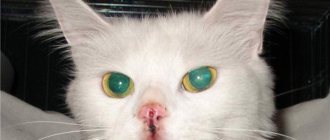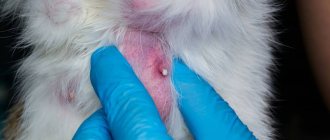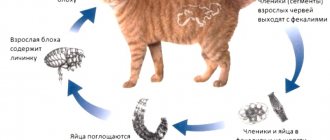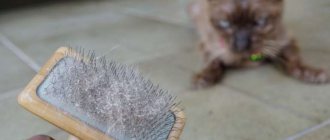Every owner wants his pet to live happily ever after. Therefore, any disease is a small tragedy. But it’s especially scary when an animal is suffering and you can’t help it. Many cat owners will understand what we're talking about. This is the moment when sores appear on the cat’s neck, and she literally scratches them down to the meat with her clawed paws. Areas that are particularly susceptible to this condition are also the areas behind the ears. What is it, where does it come from, and what should the owner do? We will talk about all this in order in our article.
What is the problem?
It’s very sad to see non-healing sores appear on a cat’s neck. Therefore, the best option is to take her to a veterinarian. However, it is good if you live in the city. True, in this case the person also faces a problem: veterinary clinics charge for their services, which not everyone can afford. And in small towns and villages there may not be a veterinarian at all. Therefore, let's look at the main reasons why sores appear on a cat's neck, and ways to combat them.
The main causes of hair loss
In order not to panic prematurely, you need to find out why the cat's hair fell out.
There are a number of objective factors under the influence of which a cat’s hair falls out:
- Seasonal shedding. During the process of physiological coat change characteristic of animals, pets behave as usual. They have a clean and moist nose and no sleep or appetite disturbances. In such cases, the owner should not be afraid that the cat’s hair has fallen out.
- Facial alopecia is also not associated with any pathologies in the animal’s body. This is a period in the life of a cat that occurs in the second year of life. It is characterized by baldness of the superciliary arches and in the behind-the-ear area. By the age of three, this symptom completely disappears.
However, there are several reasons when the owner should pay attention to the condition of the pet and think about why the cat’s hair is coming out. These include:
- Unbalanced diet and vitamin deficiency. Due to a deficiency of microelements vital for a cat’s health, premature molting occurs, which results in active hair loss in the back, on the neck and at the root of the tail. The entire coat becomes dull, and the fibers themselves become brittle.
- Hormonal imbalance can also cause hair loss. To understand why a cat's hair falls out, and whether this process is related to hormonal imbalance, it is worth observing the animal's behavior. He may urinate more often, there may be moments of refusal to eat, which are replaced by increased appetite.
- The presence of allergic manifestations may explain why a cat has a lot of hair. Allergies can be caused by long-term drug treatment or exposure to chemicals on the fur. Lint loss is usually accompanied by other symptoms. The animal experiences discomfort from itching, peeling and redness of the skin.
- Parasitic pathologies. Infestation by microscopic mites causes bald patches to form on your pet's fur. They are localized in the ears, at the root of the tail, on the muzzle and forelimbs. At the site of bald spots, foci of inflammation form in the form of red blisters. The animal experiences severe itching. Similar symptoms can occur with flea bites.
Option number 1: blood-sucking parasites
Indeed, it often happens that insects choose the neck as their favorite area for life. Therefore, the cat intensively scratches these places with its claws. As a result, if action is not taken, things will take a bad turn. Itching provokes scratching, and small sores appear on the cat’s neck. But the insects do not stop their activity and continue to bite the animal. As a result, scratching continues, dirty claws can become infected and an abscess begins.
What should the owner do? Examine the animal. If he has fleas, then their locations should be visible on the neck and near the tail. Adult insects and their eggs can be found. In this case, you need to treat the animal for insects, and then treat the wounds. You can use a special collar or drops on the withers. Once the source of the itching is eliminated, it will be much more effective.
The cat itches until it hurts and the hair falls out: How to treat it at home?
Every owner should understand that many drugs that can be used by humans and other animals cannot be used on cats.
For example, skin lesions are often treated with Yam BK ointment. This is strictly forbidden, since the tar contained in this drug is toxic to cats.
Like this article? Read other materials about cats on our website: How to give medicine to a cat? Tips for ensuring comfort for a cat - How to learn to understand your cat (Practical tips) -
How can you help yourself without causing harm?
Try to limit access to the body area if the cat injures itself. A protective collar or blanket can help with this.
Trim your cat's claws or apply safe anti-scratch pads.
Itching can be controlled using a suspension or spray with the same name Stop Itching . It is important to understand that you will only remove the symptom, and after a course of the drug the problem may return.
The crusts can be soaked and removed using saline or Chlorhexedine.
Also, if there has been no treatment for fleas and ticks for a long time (the apple tree is a month old), it is worth doing it. Suitable drugs: Stronghold, Lawyer, Helmintal, Inspector, Bravecto.
And, of course, we recommend taking your pet to see a doctor as soon as possible.
Subcutaneous mites
If your cat itches until there are sores on its neck, but no fleas are found, perhaps the cause lies somewhat deeper. It can also be skin diseases, which are a reaction to the activity of subcutaneous mites. They can also be different, but most often they diagnose demodex or sarcoptic mange. In this case, it is also advisable to first have an examination by a veterinarian. If the scraping shows a positive result, the doctor will prescribe the optimal treatment. Usually these are Ivermek injections, or taking it orally according to a special regimen. Intramuscular injections are given every 8-10 days. In total, you need to do three procedures, and you can forget about the problem.
If your cat scratches its neck until it hurts, but there is no way to get to the veterinarian, you can try Ivermec (gel). Just don't apply it to wounds, otherwise you may increase irritation. In addition, Stronghold and Frontline drops are on sale. They are affordable and freely sold through a network of veterinary pharmacies.
Alopecia in cats: symptoms and causes
1332 views
Throughout the year, cats shed a small amount of hair; many shed consistently twice a year: in autumn and spring. But if you notice patchy hair loss in a cat in the head, neck, groin, sides, stomach, or paws, most likely this is alopecia, and the animal needs to be examined.
Symptoms of alopecia in cats
It is not difficult to distinguish alopecia from seasonal hair loss, which is normal for all cats. As a rule, alopecia is completely hairless or covered with very sparse hair areas on the cat’s body.
Alopecia is often accompanied by peeling of the skin, redness, crusting, and itching. There is symmetrical alopecia on both sides, near the ears or on other parts of the body, as well as complete baldness of individual areas of the skin (abdomen, groin, limbs, etc.).
If a cat often licks itself, scratches the same place, or bites areas of skin, this is a reason for a thorough examination. It is possible that the animal will develop diseases.
Let's look at the 10 main reasons why alopecia occurs. Remember that this disease requires consultation with a specialist.
Causes of hair loss in cats and treatment
1) Hypotrichosis is a genetic disorder that is inherited. Most often it begins to appear at an early age: the kitten loses fur, then grows it again. This pathology is extremely rare, does not threaten the health of the animal, but, unfortunately, has practically no treatment. It is recommended to exclude such animals from breeding.
2) Obesity is associated with skin diseases such as inflammation of the sebaceous glands, dermatitis and alopecia. The inability of obese cats to properly groom their coat can lead to baldness. In this case, the cat should be switched to a special food that promotes weight loss.
3) Vitamin A deficiency, which cats are not able to synthesize on their own and require its presence in food. A cat with a deficiency of vitamin A worsens the condition of the skin and coat, develops alopecia and generalized flaking of the skin.
Your veterinarian will help you choose the right diet with a sufficient amount of vitamin A: it is not recommended to introduce it into your cat’s diet on your own, since hypervitaminosis also causes intoxication in cats.
4) Food intolerance or allergies often manifest in cats as itchy skin, which causes the animal to injure itself. Additionally, food allergies can manifest as respiratory and digestive disorders (diarrhea), eosinophilic granuloma, and the appearance of areas of alopecia. After consultation with a specialist, an elimination diet or transfer to a special food is possible.
5) Psychogenic alopecia occurs in a cat experiencing stress. Such an animal begins to lick itself excessively in order to calm itself. Psychogenic alopecia is not very common and is treated with drug behavior modification therapy.
Many animals suspected of having psychogenic alopecia actually suffer from allergies (not just food allergies, but also allergies to flea bites, cosmetics, and other inhaled allergens), which causes the animal to itch. This diagnosis can be verified using an elimination diet.
6) A reaction to medications may manifest itself in the form of alopecia. In this case, it is necessary to discontinue or replace the drug after consultation with a veterinarian.
7) Endocrine alopecia is a hormonal imbalance in an animal. This can occur after sterilization, due to improper functioning of the thyroid gland (hyperthyroidism or hypothyroidism), hyperfunction of the adrenal glands, and diabetes mellitus. With endocrine alopecia, bare areas on the cat's body are most often symmetrical and located on the sides.
 Infections and parasites, such as microsporia, trichophytosis (lichen) and other fungal infections (favus), pyoderma (bacterial infection), otodectosis (ear scabies) and skin mites (cat scabies (notoedrosis, sarcoptic mange), demodicosis), fleas, lice and the like can cause itching, rashes, and alopecia. With this type of alopecia, bald areas are usually covered with scratches and other pathological formations.
Infections and parasites, such as microsporia, trichophytosis (lichen) and other fungal infections (favus), pyoderma (bacterial infection), otodectosis (ear scabies) and skin mites (cat scabies (notoedrosis, sarcoptic mange), demodicosis), fleas, lice and the like can cause itching, rashes, and alopecia. With this type of alopecia, bald areas are usually covered with scratches and other pathological formations.
9) The fungus that causes ringworm can be contagious to people, so it is best not to delay treatment. With fungal alopecia, baldness often occurs in smooth, round areas, like spots. Parasitic, fungal, and bacterial skin diseases are diagnosed only during a visit to the clinic.
10) Mechanical alopecia is the most easily removable. If areas of baldness are clearly visible under a collar, harness, or after an injury, a fight with another cat, no special treatment is required, and the animals usually quickly grow new hair.
cat dermatology allergy
Share
If all else fails
The most difficult moment for a loving owner is when he tries different methods one after another, but nothing works. The cat has a sore on her neck, a blood scab, which is also beginning to rot. Until you find the cause, you need to fight at least the effect so as not to trigger the disease. In this case, it is best to choose Terramycin or Amidel spray. They help dry wounds very well and relieve inflammation. But the effect will be temporary, since we have not yet eliminated the cause. However, it is important not to make the situation worse with sepsis, so continue to look for treatment options and in the meantime, keep using the spray or ointment.
Allergic reaction
If a cat has blood sores on its neck, then you need to think about what this might be connected with. Perhaps you recently introduced a new food into your diet, underwent a course of treatment, or purchased a vitamin complex. Then an allergic reaction cannot be ruled out. Only a doctor can make such a diagnosis, because the symptoms are too vague. Itching, hair loss and scratching can indicate dozens of reasons, including diseases of the internal organs.
However, food allergies are just one option. Pollen and house dust, mold or household chemicals, and hygiene products can provoke such a reaction. Today there are many allergens in the environment, and it will take you a very long time to look for the true cause on your own. However, in order to make a diagnosis, you can undergo a course of treatment with antihistamines. If as a result the condition begins to improve, then you are on the right track. Now all that remains is to find the source of the allergic reaction, and the problem will be solved.
What to do immediately if you discover baldness on a pet
For reference! It doesn't matter what breed the cat is, all breeds lose hair, including hair from the neck. Neither flock or velor sphinxes, nor other noble breeds, nor farm animals with stronger immunity are immune from this phenomenon.
© shutterstock
Why is this happening? In order to answer this question, you need :
- Completely examine the animal, and not only the neck, but also all its parts: ears, paws, tail.
- Pay close attention to any damage to your cat's skin. Perhaps there is no baldness there, but there are wounds similar to those on the neck.
- Analyze how you care for your pet. This may be the reason why your cat is losing hair on its neck. Therefore, it is advisable to make a list of the foods you keep your cat on. Add care products, such as shampoo, to the list. Remember and write down whether you give your cat medications: fleas, worms, vitamins, contraceptives or behavior-correcting medications.
Why is all this important? To accurately diagnose and begin treatment.
Miliary dermatitis
If the sores on the cat’s neck under the fur look like a scattering of small pimples, then the doctor can make such a diagnosis. In fact, this will only mean one thing: you need to immediately look for a new veterinarian who is more competent. The fact is that miliary dermatitis is not a disease, but only a symptom of it. Moreover, there can be countless reasons, which the doctor must deal with. You need to start from the localization of the rash. In some cases it covers only the neck, in others it spreads to the entire body.
This condition can be caused by allergic reactions. In this case, it is extremely important to determine the cause of its occurrence. This could be a reaction to fleas, inhaled allergens, or food. Based on the location of the rash, you can roughly tell what exactly was the cause. If pimples and wounds are concentrated in the neck area, then the problem is most often a food allergy.
The cat has sores on its head and hair has come out: Causes
Many factors can contribute to hair loss and the appearance of wounds on a cat’s head, neck, withers and other parts of the body:
- Flea infestations and other parasites can cause itching, self-induced alopecia, and dermatitis.
- Allergy. It can be different: to components of the diet, to something from the environment.
- Contact dermatitis. It often occurs at the site where flea drops are used or when medications are administered subcutaneously. Crusting is often reported with Baytril injection in cats.
- Other inflammatory and non-inflammatory processes in the dermis.
How to help your pet?
What should an owner do if a cat has sores on its neck? How to treat this condition, because every day it only gets worse. Making a diagnosis begins with a series of tests. It is by learning the true cause that you can understand how to treat the animal. If miliary dermatitis is a consequence of a food allergy, then the rash will persist as long as the pet receives one or another product.
To diagnose dermatitis, you need to put your cat on a special diet. It usually includes components that she has never received before. If the symptoms disappear, then the cause has been found. Now the components of the old diet are being introduced into food one by one. As soon as the first symptoms appear, the cause is discovered. Diagnostic feeding can last up to 12 weeks and is accompanied by veterinary supervision.
Several scrapings will be taken from the cat to determine the presence of skin parasites. Three types of mites can cause skin lesions:
- Cheyletiella is often called wandering dandruff. White, moving parasites resemble flakes of dandruff. They live in the top layer of the skin.
- The second species, Otodectes cynotis, is an ear mite that also causes miliary dermatitis on the head and neck.
- Finally, the third pathogen is demodex.
Getting rid of itching is not the solution
First of all, owners strive to alleviate the condition of their pet. If you apply standard allergy treatment, the symptoms will return after a while. It is necessary to use local remedies that dry the wounds and alleviate the condition, but this is not the main focus. Therefore, the main task is to find the real reason for what is happening. Only after diagnosis can effective treatment be prescribed.
Any skin disease takes a long time to cure, so don’t be discouraged if there are no quick results. The most important thing is your attention and the support of an experienced doctor.











